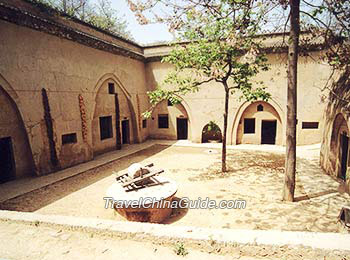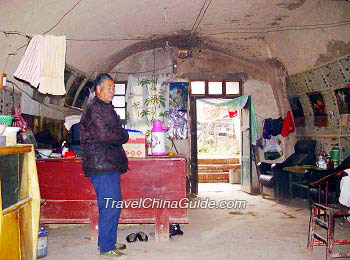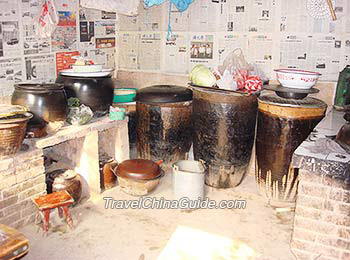A type of dwelling that exists only in China, farmers’ caves (Yaodong in Chinese) are still to be found in Turpan and Kashgar in Xinjiang; Lanzhou, Dunhuang, Pingliang and Gannan in Gansu; Yinchuan in Ningxia Hui Autonomous Municipality; Qianxian and Yan’an in Shaanxi; and Linfen and Taiyuan in Shanxi. Among them, the caves in Shaanxi province, especially in Northern Shaanxi like
Yan'an and Yulin, are unique travel destinations. According to official statistics, there are still 40 million people living in such dwellings in China.
As early as the Neolithic Age (about 18,000 years ago), using a wooden framework, grass, and soil, clans inhabiting the middle reaches of the Yellow River built simple shallow caves in natural earth holes in the mountains. Later, over 4,000 years ago, the real caves started to be constructed, which can be attributed to the natural surroundings. In the areas that are popular with such dwellings, there are very thick loess layers. People made full use of the loess layers to create the original farmers’ caves. Such dwellings were originally built into the mountain cliffs of the loess plateau and were the typical troglodytism. Living in a Yaodong was a practice handed down to descendants. Today, some have even become hotels featuring modern facilities for visitors to enjoy.
Appearance and Features
A cave is usually 6-8 meters (around 20-26 feet) long, around 3 meters (9.8 feet) wide and around 3 meters (9.8 feet) high. From the outside, it appears in the shape of an arc, which presents the ancient opinion of “Heaven is round and ground is square”. It has a semicircular door of fieldstone and windows with exquisite sash bars set like fan ribs, the most beautiful and dainty parts sometimes decorated by the family with folk paper cuttings.
The most important and unique characteristic of a Yaodong is that inside it is cool in summer and warm in winter. Generally, the temperature in the room remains between 10

C (50

F ) to 22

C (72

F) and the relative humidity is 30% - 75%. The comfortable temperature and humidity help keep the dwellers fit to some degree. The natural architectural features protect the cave dwellers from being affected by the changes of environment or weather. Besides, its creation does not damage the environment or usurp farmland. Another feature is that you will feel quite quiet inside.
In Yan’an in Northern Shaanxi, a family usually has 3 to 5 caves. The middle one is the principal residence, in which the grandparents or parents live. At the bottom right of each cave, people usually leave a small horizontal pass for their pets, such as cats or dogs, to go through. When constructing the gate for the whole yard, there is a traditional taboo that none of the caves should be in line with the gate. Otherwise, bad luck may fall upon this family.
Generally, Shaanxi’s farmers’ caves have three basic sorts: earth type, brick type and stone type.
Earth Cave
Earth ones are usually cut into the side of a mountain cliff. You can still see them at Wangjiaping, Yangjialing and Date Garden (Zaoyuan) areas in Yan’an, Shaanxi. In these residences are very simple furniture, such as a wooden table, wooden chairs, an earth sleeping platform (Kang) and other farmers’ things.
Brick Cave and Stone Cave
Brick and stone ones are most common in present Northern Shaanxi rural areas. Their overall framework is built with bricks or stones, while the door and window frameworks are mostly made of wood or aluminum alloy. People also add different patterns or statues like two pigeons at the front top of their dwellings when reconstructing the residences’ tops, which help the dwellings to be more delicate and modern. There is also a combination-style cave that is mainly constructed of earth but the front is made of stones or bricks.
Before 1949, the former collective leadership, including Chairman Mao and Chu Teh stayed in Yan’an for some time, living in these farmers’ caves. There are still some sites left in Pheonix Hill, Yangjialing and Date Garden areas. Nowadays, many visitors go there to see the residences in which the great leaders made their contributions to China’s foundation. During your stay in Shaanxi, a visit to the farmers’ caves is well worth adding to your list of things to see.
- Last updated on Aug. 15, 2024 by Catherine He -
 C (50
C (50 F ) to 22
F ) to 22 C (72
C (72 F) and the relative humidity is 30% - 75%. The comfortable temperature and humidity help keep the dwellers fit to some degree. The natural architectural features protect the cave dwellers from being affected by the changes of environment or weather. Besides, its creation does not damage the environment or usurp farmland. Another feature is that you will feel quite quiet inside.
F) and the relative humidity is 30% - 75%. The comfortable temperature and humidity help keep the dwellers fit to some degree. The natural architectural features protect the cave dwellers from being affected by the changes of environment or weather. Besides, its creation does not damage the environment or usurp farmland. Another feature is that you will feel quite quiet inside.

